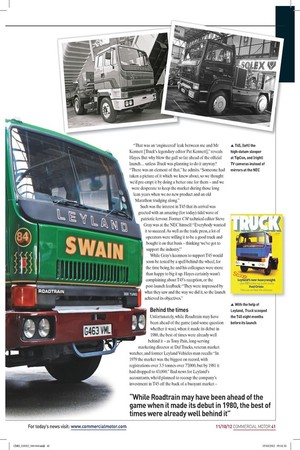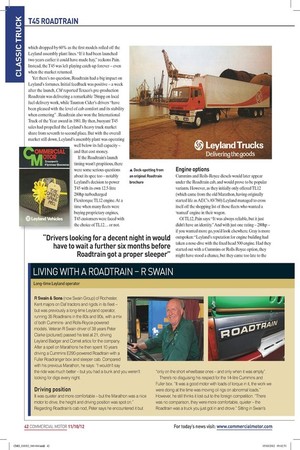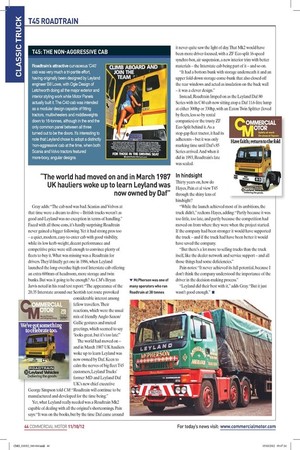Too little,
Page 33

Page 34

Page 35

Page 36

Page 37

If you've noticed an error in this article please click here to report it so we can fix it.
too late
Leyland’s T45 Roadtrain was meant to be the truck that was going to finally see off the competition from all those cheeky continentals... so what went wrong?
Words: Brian Weatherley / Images: CM, TRUCK, Brian Weatherley, Eric Taylor, Richard Stanier, John Henderson
February 1980 – it was a cold night in Birmingham, and Leyland Vehicles’ communications and public affairs director Martin Hayes was feeling nervous. Looking out over the expectant crowd gathered for the official launch of the T45 Roadtrain at the NEC, not all the signs were auspicious. Inside, the assorted guests mingled expectantly amongst the tropically themed ‘Hawaiian Night’ BBQ stands. Outside, no less than 40 new Roadtrain tractors stood in the chilly night air outside — a state Hayes hoped wouldn’t extend to the assembled throng within. For their part the NEC authorities weren’t about to let things get too ‘hot’, as Hayes recalls. “Behind every bit of set-building was a fireman with an extinguisher ready to put out the blaze – they all believed we were going to burn down the pride of Birmingham!” Not that Roadtrain’s arrival was totally unexpected. Six month’s earlier Truck magazine had splashed a full-colour photo of the T45 all over its front cover, along with the headline ‘Scoop—Leyland’s new heavyweight!’ Inside, was a remarkably accurate description of the truck too, eight months before it actually broke cover. “That was an ‘engineered’ leak between me and Mr Kennett [Truck’s legendary editor Pat Kennett],” reveals Hayes. But why blow the gaff so far ahead of the official launch... unless Truck was planning to do it anyway? “There was an element of that,” he admits. “Someone had taken a picture of it which we knew about, so we thought we’d pre-empt it by doing a better one for them – and we were desperate to keep the market during those long lean years when we no new product and an old Marathon trudging along.” Such was the interest in T45 that its arrival was greeted with an amazing (for today) tidal wave of patriotic fervour. Former CM technical editor Steve Gray was at the NEC himself: “Everybody wanted it to succeed. As well as the trade press, a lot of operators were willing it to be a good truck and bought it on that basis – thinking ‘we’ve got to support the industry’.” While Gray’s keenness to support T45 would soon be tested by a spell behind the wheel, for the time being, he and his colleagues were more than happy to big it up. Hayes certainly wasn’t complaining about T45’s reception, or the post-launch feedback: “They were impressed by what they saw and the way we did it, so the launch achieved its objectives.”
Behind the times
Unfortunately, while Roadtrain may have been ahead of the game (and some question whether it was), when it made its debut in 1980, the best of times were already well behind it – as Tony Pain, long-serving marketing director at Daf Trucks, veteran market watcher, and former Leyland Vehicles man recalls: “In 1979 the market was the biggest on record, with registrations over 3.5 tonnes over 77,000, but by 1981 it had dropped to 43,000.” Bad news for Leyland’s accountants, who’d planned to recoup the company’s investment in T45 off the back of a buoyant market – which dropped by 60% as the first models rolled off the Leyland assembly plant lines. “If it had been launched two years earlier it could have made hay,” reckons Pain. Instead, the T45 was left playing catch-up forever – even when the market returned.
Yet there’s no question, Roadtrain had a big impact on Leyland’s fortunes. Initial feedback was positive – a week after the launch, CM reported Texaco’s pre-production Roadtrain was delivering a remarkable 7.8mpg on local fuel-delivery work, while Taunton Cider’s drivers “have been pleased with the level of cab comfort and its stability when cornering” . Roadtrain also won the International Truck of the Year award in 1981. By then, buoyant T45 sales had propelled the Leyland’s heavy truck market share from seventh to second place. But with the overall market still down, Leyland’s assembly plant was operating well below its full capacity – and that cost money.
If the Roadtrain’s launch timing wasn’t propitious, there were some serious questions ▲ Dock-spotting from about its spec too – notably an original Roadtrain Leyland’s decision to power brochure T45 with its own 12.5-litre 280hp turbocharged Flexitorque TL12 engine. At a time when many fleets were buying proprietary engines, T45 customers were faced with the choice of TL12... or not.
Engine options
Cummins and Rolls-Royce diesels would later appear under the Roadtrain cab, and would prove to be popular variants. However, as they initially only offered TL12 (which came from the old Marathon, having originally started life as AEC’s AV760) Leyland managed to cross itself off the shopping list of those fleets who wanted a ‘named’ engine in their wagon.
Of TL12, Pain says: “It was always reliable, but it just didn’t have an identity.” And with just one rating – 280hp – if you wanted more go, you’d look elsewhere. Gray is more outspoken: “Leyland’s reputation for engine building had taken a nose-dive with the fixed head 500 engine. Had they started out with a Cummins or Rolls-Royce option, they might have stood a chance, but they came too late to the party with proprietary engines, which in those days were still in vogue.” Then there was Roadtrain’s gearbox – the 10-speed Spicer SST10 splitter. That Leyland didn’t fit the more popular Fuller Roadranger surprised many observers, while others couldn’t help pointing out Leyland’s Continental rivals were fitting more driver-friendly synchromesh transmissions rather than constant-mesh boxes. Pain describes the decision to fit the Spicer as typifying Leyland’s then engineering-led approach. “It was cheaper, lighter and reliable. Unfortunately, you couldn’t do a clean shift with it,” he adds. “What Leyland hadn’t recognised was the need for a synchromesh gearbox, whereas Scania, Volvo and Daf had.” Gray adds: “It wasn’t a very good shift at all.” Drivers looking for a decent night out would also have to wait a further six months before Roadtrain got a proper sleeper when the high-datum C40 cab bowed in at the 1980 Motor Show.
As CM engineering editor Graham Montgomerie noted at the time: “It’s good to see the Roadtrain on the Leyland Vehicles’ stand, with pride of place going to the new sleeper cab version.” However, he added: “Although the proprietary engines now available for the Roadtrain [the Rolls 265L and the Cummins NT 240] are carefully selected not to clash with Leyland’s own TL 12 on power output, I wonder if some operators will lean on LV to offer high-powered proprietary alternatives.”
Sales focus
Although Roadtrain propelled Leyland forward from a product perspective, its sales focus was still based on fighting to retain its presence within the bigger UK fleets, where the T45 carved out a strong following, rather than trying to woo the larger number of small hauliers and drivers as its Continental rivals were doing. It’s a point picked up by Pain. “T45’s biggest strength in many respects was its modern appearance, reasonably up-to-date, lightweight, good payload, with known parts availability and service and a reasonable dealer network. Its weakness was it never appealed to enthusiastic drivers.” Even the best salesmen couldn’t gloss over another of Roadtrain’s faults – as CM road tester Tim Blakemore noted after driving a 32-tonne 1628 Roadtrain over our Scottish test route. On rough or undulating road surfaces, he said: “I was uncomfortably aware of the cab nod and, as one of Leyland's major objectives with T45 was to improve the ride, it was surprising to find that this fault had cropped up again.” Gray adds: “The cab nod was bad. Scanias and Volvos at that time were a dream to drive – British trucks weren’t as good and Leyland was no exception in terms of handling.” Faced with all those cons, it’s hardly surprising Roadtrain never gained a bigger following. Yet it had strong pros too – a quiet, modern, easy-to-enter cab with good visibility, while its low kerb-weight, decent performance and competitive price were still enough to convince plenty of fleets to buy it. What was missing was a Roadtrain for drivers. They’d finally get one in 1986, when Leyland launched the long-overdue high-roof Interstate cab offering an extra 600mm of headroom, more storage and twin bunks. But was it going to be enough? As CM’s Bryan Jarvis noted in his road test report: “The appearance of the 20.35 Interstate around our Scottish test route provoked considerable interest among fellow travellers. Their reactions, which were the usual mix of friendly Anglo-Saxon/ Gallic gestures and muted greetings, which seemed to say ‘looks great, but it’s too late’.” The world had moved on – and in March 1987 UK hauliers woke up to learn Leyland was now owned by Daf. Keen to calm the nerves of big fleet T45 customers, Leyland Trucks’ former MD and Leyland Daf UK’s new chief executive George Simpson told CM: “Roadtrain will continue to be manufactured and developed for the time being.” Yet, what Leyland really needed was a Roadtrain Mk2 capable of dealing with all the original’s shortcomings. Pain says: “It was on the books, but by the time Daf came around it never quite saw the light of day. That Mk2 would have been more driver-focused, with a ZF Eco-split 16-speed synchro box, air suspension, a new interior trim with better materials – the Interstate cab being part of it – and so on.
“It had a bottom bunk with storage underneath it and an upper fold-down storage-come-bunk that also closed off the rear windows and acted as insulation on the back wall – it was a clever design.” Instead, Roadtrain limped on as the Leyland Daf 80 Series with its C40 cab now sitting atop a Daf 11.6-litre lump at either 300hp or 330hp, with an Eaton Twin Splitter (loved by fleets, less so by rental companies) or the trusty ZF Eco-Split behind it. As a stop-gap fleet tractor, it had its adherents – but it was only marking time until Daf’s 85 Series arrived. And when it did in 1993, Roadtrain’s fate was sealed.
In hindsight
Thirty years on, how do Hayes, Pain et al view T45 through the shiny lens of hindsight?
“While the launch achieved most of its ambitions, the truck didn’t,” reckons Hayes, adding: “Partly because it was too little, too late, and partly because the competition had moved on from where they were when the project started. If the company had been stronger it would have supported the truck – and if the truck had have been better it would have saved the company.
“But there’s a lot more to selling trucks than the truck itself, like the dealer network and service support – and all those things had some deficiencies.” Pain notes: “It never achieved its full potential, because I don’t think the company understood the importance of the driver in the decision-making process.” “Leyland did their best with it,” adds Gray. “But it just wasn’t good enough.” n











































